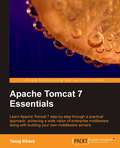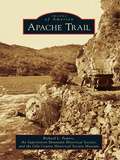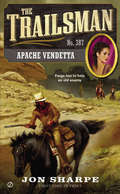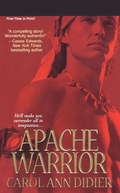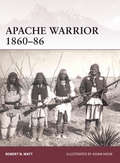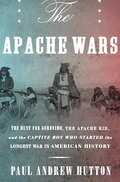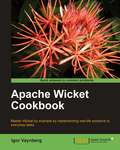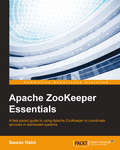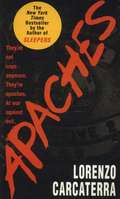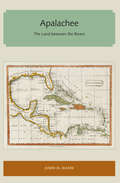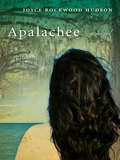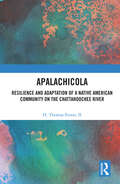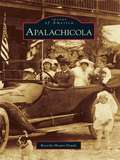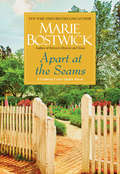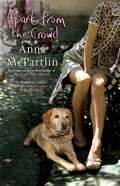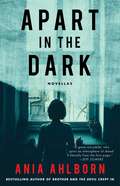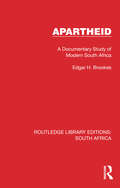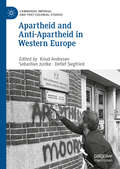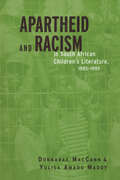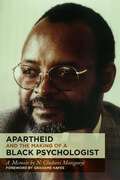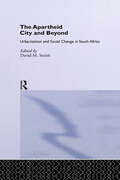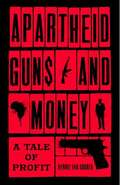- Table View
- List View
Apache Tomcat 7 Essentials
by Tanuj KhareThis book is a step-by-step tutorial for anyone wanting to learn Apache Tomcat 7 from scratch. There are plenty of illustrations and examples to escalate you from a novice to an expert with minimal strain. If you are a J2EE administrator, migration administrator, technical architect, or a project manager for a web hosting domain, and are interested in Apache Tomcat 7, then this book is for you. If you are someone responsible for installation, configuration, and management of Tomcat 7, then too, this book will be of help to you.
Apache Trail
by Gila County Historical Museum Richard L. Powers Superstition Mountain Historical SocietyPres. Theodore Roosevelt once referred to the Apache Trail as "one of the most spectacular best-worth-seeing sights of the world." The once narrow, ancient foot trail built as a supply road for the construction of Roosevelt Dam has now evolved into a state highway with majestic scenic vistas and historical grandeur. Even in the 1920s, the Southern Pacific Railroad touted this road as a "must-see side trip." Each year, thousands of people venture along the trail to take a step back in time and relish the breathtaking experience of this fabulous journey. The Fish Creek Hill section remains much as it was back in the early 1900s, a narrow one-vehicle passage on an extremely steep incline that drops 900 feet within a mile along the edge of a steep cliff. Although several miles of the road are now paved, dirt portions remain that allow tourists a sense of perilous adventure.
Apache Vendetta (Trailsman #387)
by Jon SharpeYears ago, Skye Fargo barely survived a scrap with an Apache called Red Knife. Now, Red Knife needs Fargo's help to find the white men that raped and killed his daughter. <P><P>The Army wants Fargo to do it so the Apaches will be pacified. But Red Knife wants blood, not justice--and the Trailsman soon finds himself caught between his orders and his old foe's rage...
Apache Warrior
by Didier Carol A.A white woman and an Apache brave find forbidden love in the untamed land of the Wild West. . . Unbidden Yearnings Always Lead To. . . Every day that Amanda Carroll and her sister travel farther west, they worry about possible Indian attacks. Their greatest fear becomes reality when five armed Apaches surround their coach. Brazenly confronting her attackers, Amanda looks straight into the dark eyes of their fierce leader--only to be shocked by the intense attraction she feels for this bronzed Apache warrior. . . The Most Wicked Pleasure. . . Kayto and his warriors had no intention to harm anyone, let alone the stunning woman before him. He is intrigued by her courage as she stares at him so defiantly--and a slow, searing desire ignites deep within him. Now he will not rest until the woman he dreams of day and night is his own. . .
Apache Warrior
by Carol Ann DidierA white woman and an Apache brave find forbidden love in the untamed land of the Wild West. . .Unbidden Yearnings Always Lead To. . .Every day that Amanda Carroll and her sister travel farther west, they worry about possible Indian attacks. Their greatest fear becomes reality when five armed Apaches surround their coach. Brazenly confronting her attackers, Amanda looks straight into the dark eyes of their fierce leader--only to be shocked by the intense attraction she feels for this bronzed Apache warrior. . .The Most Wicked PleasureKayto and his warriors had no intention to harm anyone, let alone the stunning woman before him. He is intrigued by her courage as she stares at him so defiantly--and a slow, searing desire ignites deep within him. Now he will not rest until the woman he dreams of day and night is his own. . .
Apache Warrior 1860-86
by Robert WattThe idea of an Apache warrior still evokes a stereotyped response; that of an elusive, cunning, ferocious and cruel fighter. Focusing on the Chiricahua Apache, led by such famous warriors as Cochise Mangas Coloradas, Victorio, Nana and Geronimo, this book explains how their upbringing, training and culture equipped them uniquely for survival in the harsh environment of New Mexico and Arizona, and enabled them to fight off their Mexican and American enemies for so long. Specially commissioned, full-colour illustrations featuring 'exploded' kit scenes and battle artwork complement meticulous research that seeks to strip away the myths behind the history of some of the most feared opponents of the US Army in the south-west United States.
The Apache Wars
by Paul Andrew HuttonIn the tradition of Empire of the Summer Moon, a stunningly vivid historical account of the manhunt for Geronimo and the 25-year Apache struggle for their homeland They called him Mickey Free. His kidnapping started the longest war in American history, and both sides--the Apaches and the white invaders--blamed him for it. A mixed-blood warrior who moved uneasily between the worlds of the Apaches and the American soldiers, he was never trusted by either but desperately needed by both. He was the only man Geronimo ever feared. He played a pivotal role in this long war for the desert Southwest from its beginning in 1861 until its end in 1890 with his pursuit of the renegade scout, Apache Kid. In this sprawling, monumental work, Paul Hutton unfolds over two decades of the last war for the West through the eyes of the men and women who lived it. This is Mickey Free's story, but also the story of his contemporaries: the great Apache leaders Mangas Coloradas, Cochise, and Victorio; the soldiers Kit Carson, O. O. Howard, George Crook, and Nelson Miles; the scouts and frontiersmen Al Sieber, Tom Horn, Tom Jeffords, and Texas John Slaughter; the great White Mountain scout Alchesay and the Apache female warrior Lozen; the fierce Apache warrior Geronimo; and the Apache Kid. These lives shaped the violent history of the deserts and mountains of the Southwestern borderlands--a bleak and unforgiving world where a people would make a final, bloody stand against an American war machine bent on their destruction.
Apache Wicket Cookbook
by Igor VaynbergThis is a hands-on practical guide to a large variety of topics and use cases. This book tries to use real-world examples when possible, but is not afraid to come up with a contrived pretext if it makes explaining the problem simpler. Unlike a lot of other books, this one does not try to maintain a continuous theme from chapter to chapter, such as demonstrating solutions on the same fictional application; doing so would be almost impossible given the wide variety of recipes presented here. Instead, this book concentrates on focused problems users are likely to encounter and shows clear solutions in a step-by-step manner. This book tries to teach by example and is not afraid to show a lot of code because, after all, it is for coders. This book is for current users of the Apache Wicket framework; it is not an introduction to Wicket that will bore you with tons of theory. You are expected to have built or maintained a simple Wicket application in the past and to be looking to learn new and better ways of using Wicket. If you are ready to take your Wicket skills to the next level this book is for you.
Apache ZooKeeper Essentials
by Saurav HaloiWhether you are a novice to ZooKeeper or already have some experience, you will be able to master the concepts of ZooKeeper and its usage with ease. This book assumes you to have some prior knowledge of distributed systems and high-level programming knowledge of C, Java, or Python, but no experience with Apache ZooKeeper is required.
Apaches
by Lorenzo CarcaterraBoomer. Dead-Eye. Pins. Geronimo. Reverend Jim. Mrs. Columbo. Legends of the NYPD. Now they are apaches, working on their own to bring down the most vicious criminals working New York City today.
Apalachee: The Land between the Rivers (Florida and the Caribbean Open Books Series)
by John H. HannThe books in the Florida and the Caribbean Open Books Series demonstrate the University Press of Florida’s long history of publishing Latin American and Caribbean studies titles that connect in and through Florida, highlighting the connections between the Sunshine State and its neighboring islands. Books in this series show how early explorers found and settled Florida and the Caribbean. They tell the tales of early pioneers, both foreign and domestic. They examine topics critical to the area such as travel, migration, economic opportunity, and tourism. They look at the growth of Florida and the Caribbean and the attendant pressures on the environment, culture, urban development, and the movement of peoples, both forced and voluntary.The Florida and the Caribbean Open Books Series gathers the rich data available in these architectural, archaeological, cultural, and historical works, as well as the travelogues and naturalists’ sketches of the area prior to the twentieth century, making it accessible for scholars and the general public alike.The Florida and the Caribbean Open Books Series is made possible through a grant from the National Endowment for the Humanities and the Andrew W. Mellon Foundation, under the Humanities Open Books program.
Apalachee: A Novel
by Joyce Rockwood HudsonIn this &“deeply involving&” novel set in colonial Florida, a Native American woman is torn away from her husband and sold into slavery (Booklist). Spanish missionaries have settled in the Apalachee homeland on the Florida panhandle, introducing new diseases to the native population and attempting to convert them to Christianity. Despite these changes, the Apalachees maintain an uneasy coexistence with the friars. Everything changes when English soldiers and their Indian allies from the colony of Carolina invade Spanish Florida. After being driven from her Apalachee homeland by the English, Native American wise woman Hinachuba Lucia is captured by Creek Indians and sold into slavery in Carolina, where she becomes a house slave at Fairmeadow, a turpentine plantation near Charles Town. Her beloved husband, Carlos, is left behind—free but helpless to get Lucia back. Swept by inexorable currents, Lucia&’s fate is interwoven with those of Juan de Villalva, a Spanish mission priest, and Isaac Bull, an Englishman in search of fortune in the New World. As the three lives unfold, we are drawn into a complex world where cultures meet and often clash. With compelling drama and historical accuracy, Apalachee portrays the decimation of the Indian mission culture of Spanish Florida by English Carolina during Queen Anne&’s war at the beginning of the eighteenth century—and the little-known institution of Indian slavery in America. &“[A] sweeping novel of Native American life during the early colonial period.&”—Publishers Weekly &“This richly textured story follows the intertwined lives of Native American, Spanish, and British characters…Clearly a meticulous researcher, Hudson does the reader an additional service by providing notes at the end.&”—Historical Novel Society
Apalachicola: Resilience and Adaptation of a Native American Community on the Chattahoochee River
by H. Thomas Foster IIThis book is a synthesis of research spanning archaeology, geology, geography, history, ecology, and ethnography. It follows the history of the Apalachicola people who contributed to the culture that was later called the Creek Indians in the Southeastern United States. Apalachicola is the origin story of the Creek Indians and how they adapted to a changing environment and shows that specific institutions, subsistence strategies, and social organizations developed as a risk management strategy and a form of resilience. It is unique in its comprehensive and long-term study of a community. It identifies and demonstrates a new way of understanding the development of political institutions and regime change. Incorporating the role of social groups that are under discussed by archaeological studies, the book offers a new and novel understanding of the development of complex societies in the southeastern United States. It is also includes a holistic view of the entire social and economic organizations rather than just an aspect of the economy or politics and shows how this culture developed a society that dealt with an unpredictable environment by distributing risks, knowledge, and authority throughout the society. The social and political organization of these Native American peoples was adapted to a particular environment that was altered when Europeans immigrated to the Americas. The book is relevant to scholars interested in Southeastern North American archaeology and history, ecological resilience, political change, colonialism, gender studies, ecology, and more.
Apalachicola (Images of America)
by Beverly Mount-DoudsOnce the third-largest port on the Gulf of Mexico, Apalachicola's diverse and colorful past remains visible today. With more than 900 historic homes and buildings in the National Register Historic District, visitors are invited to stroll along the picturesque, tree-lined streets where Victorian homes display the charm of years gone by. This delightful little fishing village has a warm and friendly atmosphere, making it even more appropriate that Apalachicola's name is a Native American word meaning "friendly people." When Apalachicola was established in 1831, its major industry was the shipping of cotton, and the city soon became an important port on the Gulf of Mexico. When the railroads expanded throughout the United States, Franklin County developed several large lumber mills to harvest and process wood from the surrounding cypress forests. These lumber magnates built many of the magnificent historic homes that still line Apalachicola's streets today.
Apart at the Seams: Cobbled Court Quilts (Cobbled Court Quilts #6)
by Marie BostwickNew York Times bestselling author Marie Bostwick welcomes readers back to picturesque New Bern, Connecticut--a perfect place for a woman whose marriage is in turmoil to discover a new pattern for living. . .Twice in her life, college counselor Gayla Oliver fell in love at first sight. The first time was with Brian--a lean, longhaired, British bass player. Marriage followed quickly, then twins, and gradually their bohemian lifestyle gave way to busy careers in New York. Gayla's second love affair is with New Bern, Connecticut. Like Brian, the laid back town is charming without trying too hard. It's the ideal place to buy a second home and reignite the spark in their twenty-six year marriage. Not that Gayla is worried. At least, not until she finds a discarded memo in which Brian admits to a past affair and suggests an amicable divorce. Devastated, Gayla flees to New Bern. Though Brian insists he's since recommitted to his family, Gayla's feelings of betrayal may go too deep for forgiveness. Besides, her solo sabbatical is a chance to explore the creative impulses she sidelined long ago--quilting, gardening, and striking up new friendships with the women of the Cobbled Court circle--particularly Ivy, a single mother confronting fresh starts and past hurts of her own. With all of their support, Gayla just might find the courage to look ahead, decide which fragments of her old life she wants to keep, which are beyond repair--and how to knot the fraying ends until a bold new design reveals itself. . .
Apart at the Seams (Tearoom Mysteries #20)
by Amy WoodsAs the glorious Maine summer wraps up and Lancaster residents eagerly anticipate a Labor Day clambake, the Whisper Art Gallery hosts a special exhibit showcasing military memorabilia to honor local American heroes. The night after the exhibit opening, the sound of a tussle and a gunshot wakens the Leon sisters, who enter their gallery to discover that a huge bag of money has been left behind. Who shot the gun? Was it the same person who left the money behind? And what did the culprits want? As Elaine and Jan investigate, finding answers turns out to be more challenging and far-reaching than they could have imagined. Meanwhile, much to Elaine's delight, her daughter, Sasha, has moved back to Lancaster. But Sasha starts to wonder: did she act in haste--or for the wrong reasons? Is Brody really worth the massive life change? Mix together one stately Victorian home, a charming lakeside town in Maine, and two adventurous cousins with a passion for tea and hospitality. Add a large scoop of intriguing mystery and sprinkle generously with faith, family, and friends, and you have the recipe for Tearoom Mysteries.
Apart from the Crowd
by Anna McpartlinIn a little Irish town like Kenmare, there's no need to worry whether people will discover your secrets. They already have. For Mary, that means being remembered for her tragic losses, even if she'd rather get on with her life. For her cousin Ivan, as close as a brother, the gossip is all about how his wife took the kids and ran off with her new lover. For Mary's friend Penny, it's an old romance that didn't work out quite right, and a current affair with a bottle of vodka. Then Sam Sullivan rents the cottage next door to Mary, and within hours the whole town is talking about the film-star-handsome American. When Sam hurts his back while helping his new neighbor and spends the next week confined to a mattress on her floor, gossip runs rampant. But neither Kenmare nor Mary know about the secrets Sam is so successfully hiding. . . . For Mary's circle of friends, Sam's arrival marks more than one change. And Mary -- whose unlucky history has kept her apart from the crowd much of her life -- has finally found a man with whom she feels she might truly connect. But so long as both are captive to memories they dare not reveal, the past is a barrier that will keep them forever alone. In this powerful novel, Anna McPartlin perfectly captures the drama, the emotion, and the laughter of a small Irish community, for those who fit in -- and those who don't. Apart from the Crowd mixes wit and insight to create an engrossing tale that will keep you reading to the very last page.
Apart in the Dark: Novellas
by Ania AhlbornTwo terrifying novellas from bestselling author Ania Ahlborn, &“a great storyteller who spins an atmosphere of dread literally from the first page&” (Jeff Somers).The Pretty Ones New York, 1977. The sweltering height of the Summer of Sam. The entire city is gripped with fear, but all Nell Sullivan worries about is whether or not she&’ll ever make a friend. The self-proclaimed &“Plain Jane&” does her best to fit in with the girls at work, but Nell&’s brother, Barrett, assures her that she&’ll never be like them. When Nell manages to finally garner some much-yearned-for attention, the unthinkable happens to her newfound friend. The office pool blames Son of Sam, but Nell knows the awful truth…because doing the devil&’s work is easy when there&’s already a serial killer on the loose. I Call Upon Thee Maggie Olsen had a pretty ordinary childhood—swimming and sleepovers, movie nights and dad jokes. And then there were the other things…the darker things…the shadow that followed her home from the cemetery and settled into the corners of her home, refusing to let her grow up in peace. Now, after three years away from the place she's convinced she inadvertently haunted, and after yet another family tragedy strikes, Maggie is forced to return to the sweltering heat of a Savannah summer to come to terms with her past. All along, she's been telling herself, it was just in your head, and she nearly convinces herself that she'd imagined it all. But the moment Maggie steps into the foyer of her family home, she knows. The darkness is still here. And it's been waiting for Maggie's return…
Apartamento Partilha-se
by Beth O'LearyE SE TIVESSE DE PARTILHAR A CAMA COM ALGUÉM QUE NUNCA CONHECEU? Tiffy Moore precisa urgentemente de um apartamento barato, depois de o ex-namorado a despejar da casa onde viviam. Leon Twomey é enfermeiro, faz os turnos da noite no hospital, tem um apartamento para arrendar e precisa de dinheiro para ajudar o seu irmão. Para os dois, surge a solução perfeita: durante o dia, enquanto Tiffy está a trabalhar, Leon descansa do lado direito da cama; durante a noite, e até à manhã seguinte, Tiffy é dona e senhora do apartamento. Embora nenhum deles se encontre no mesmo espaço ao mesmo tempo, limitando as hipóteses de algo poder correr mal, os seus amigos acham que esta é a receita para o desastre e que devem existir regras. Para que tudo possa correr bem, decidem comunicar apenas por bilhetinhos destinados a resolver questões domésticas (e da vida) e facilitar a partilha do apartamento. Mas, com ex-namorados dramáticos, colegas de trabalho doidos e, claro está, o facto de ainda não se terem cruzado, estão prestes a descobrir que, para terem uma casa perfeita, vão precisar de atirar as regras pela janela.
Apartheid: A Documentary Study of Modern South Africa (Routledge Library Editions: South Africa #2)
by Edgar H. BrookesOriginally published in 1968, this volume traces the history and growth of Apartheid in South Africa. The acts which enforced Apartheid – the Group Areas Act, Population and Registration Act are given in full. The book also includes documents which reflected reaction to these measures: Parliamentary debates, newspaper reports and policy statements by the leading political parties and religious denominations. The documents are headed by a full historical and analytical introduction.
Apartheid and Anti-Apartheid in Western Europe (Cambridge Imperial and Post-Colonial Studies)
by Knud Andresen Sebastian Justke Detlef SiegfriedThis edited collection examines how Western European countries have responded and been influenced by the apartheid system in South Africa. The debate surrounding apartheid in South Africa underwent a shift in the second half of the 20th century, with long held positive, racist European opinions of white South Africans slowly declining since decolonisation in the 1960s, and the increase in the importance of human rights in international politics. While previous studies have approached this question in the context of national histories, more or less detached from each other, this edited collection offers a broader insight into the transnational and entangled histories of Western European and South African societies. The contributors use exemplary case studies to trace the change of perception, covering a plurality of reactions in different societies and spheres: from the political and social, to the economic and cultural. At the same time, the collection emphasizes the interconnections of those reactions to what has been called the last ‘overtly racist regime’ (George Frederickson) of the twentieth century.
Apartheid and Racism in South African Children's Literature 1985-1995: Apartheid And Racism In South African Children's Literature 1985-1995 (Children's Literature and Culture #15)
by Donnarae MacCann Yulisa Amadu MaddyFirst Published in 2002. Routledge is an imprint of Taylor & Francis, an informa company.
Apartheid and the Making of a Black Psychologist: A memoir
by N. Chabani ManganyiThis intriguing memoir details in a quiet and restrained manner with what it meant to be a committed black intellectual activist during the apartheid years and beyond. Few autobiographies exploring the ‘life of the mind’ and the ‘history of ideas’ have come out of South Africa, and N Chabani Manganyi’s reflections on a life engaged with ideas, the psychological and philosophical workings of the mind and the act of writing are a refreshing addition to the genre of life writing. Starting with his rural upbringing in Mavambe, Limpopo, in the 1940s, Manganyi’s life story unfolds at a gentle pace, tracing the twists and turns of his journey from humble beginnings to Yale University in the USA. The author details his work as a clinical practitioner and researcher, as a biographer, as an expert witness in defence of opponents of the apartheid regime and, finally, as a leading educationist in Mandela’s Cabinet and in the South African academy.Apartheid and the Making of a Black Psychologist is a book about relationships and the fruits of intellectual and creative labour. Manganyi describes how he used his skills as a clinical psychologist to explore lives – both those of the subjects of his biographies and those of the accused for whom he testified in mitigation; his aim always to find a higher purpose and a higher self.
The Apartheid City and Beyond: Urbanization and Social Change in South Africa
by David M. SmithApartheid as legislated racial separation substantially changed the South African urban scene. Race group areas' remodelled the cities, while the creation of homelands', mini-states and the pass laws' controlling population migration constrained urbanization itself. In the mid-1980s the old system - having proved economically inefficient and politically divisive - was replaced by a new policy of orderly urbanization'. This sought to accelerate industrialization and cultural change by relaxing the constraints on urbanization imposed by state planning. The result was further political instability and a quarter of the black (or African) population housed in shanty towns. Negotiations between the Nationalist government and the African National Congress are working towards the end of the old apartheid system. Yet the negation of apartheid is only the beginning of the creation of a new society. The vested interests and entrenched ideologies behind the existing pattern of property ownership survive the abolition of apartheid laws. Beyond race, class and ethnicity will continue to divide urban life. If the cities of South Africa are to serve all the people, the accelerating process of urbanization must be brought under control and harnessed to a new purpose. The contributors to this volume draw on a broad range of experience and disciplines to present a variety of perspectives on urban South Africa.
Apartheid Guns and Money: A Tale of Profit
by Hennie Van Vuuren<p>In its last decades, the apartheid regime was confronted with an existential threat. While internal resistance to the last whites-only government grew, mandatory international sanctions prohibited sales of strategic goods and arms to South Africa. To counter this, a global covert network of nearly fifty countries was built. In complete secrecy, allies in corporations, banks, governments and intelligence agencies across the world helped illegally supply guns and move cash in one of history's biggest money laundering schemes. Whistleblowers were assassinated and ordinary people suffered. <p>Weaving together archival material, interviews and newly declassified documents, Apartheid Guns and Money exposes some of the darkest secrets of apartheid's economic crimes, their murderous consequences, and those who profited: heads of state, arms dealers, aristocrats, bankers, spies, journalists and secret lobbyists. These revelations, and the difficult questions they pose, will force the new South Africa--and all who were complicit--to confront the past and be held to account.</p>
